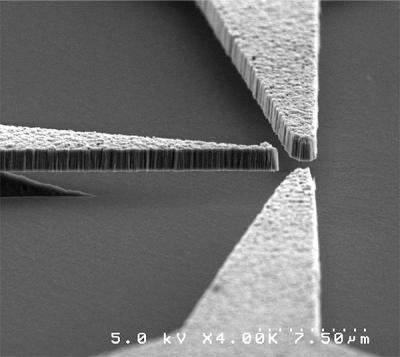Extreme Computing: Using Diamond Circuits
Engineers at Vanderbilt University in Nashville, Tennessee, stated that they created transistors and logical gates using nanodiamond films. The benefit? More performance potential, especially in extreme environments.
"Diamond-based devices have the potential to operate at higher speeds and require less power than silicon-based devices," Research Professor of Electrical Engineering Jimmy Davidson said. "Diamond is the most inert material known, so our devices are largely immune to radiation damage and can operate at much higher temperatures than those made from silicon."
Davidson said that the devices are not "exorbitantly" expensive. Due to the size of transistors and gates, a one-carat diamond is enough to create about one billion of them. However, the diamond film is created from hydrogen and methane and the "deposited form of diamond is less than one-thousandth the cost of a jewelry diamond," the researchers said. The cost of producing nanodiamond devices may be competitive with silicon as a result, they stated. A Sandy Bridge die, by the way, has 995 million transistors.
The researchers envision their invention to be used in military electronics, circuitry that operates in space, ultra-high speed switches, ultra-low power applications and sensors that operate in high radiation environments, at extremely high temperatures up to 900 degrees Fahrenheit and extremely low temperatures down to minus 300 degrees Fahrenheit.
According to Davidson, nanodiamond devices can be manufactured by processes that are commonly used by the semiconductor industry with the exception that the production of the chip needs a vacuum, which requires a modified packaging process. Davidson and his colleagues said they have investigated the packaging process and have found that the metallic seals used in military-grade circuitry "are strong enough to hold an adequate vacuum for centuries."
There was no information when such chips could actually find their way into a production process.
Get Tom's Hardware's best news and in-depth reviews, straight to your inbox.

Douglas Perry was a freelance writer for Tom's Hardware covering semiconductors, storage technology, quantum computing, and processor power delivery. He has authored several books and is currently an editor for The Oregonian/OregonLive.
-
panacuba Nice to hear that we are making some advances, I'm assuming with the recent technology that allow us to produce artificially made diamonds, the price will drop dramatically and soon we gonna see lots of diamond based devices :)Reply -
dogman_1234 There are a lot of potential applications to circuitry in computers. Graphene, photo-transistors, magnetic switches, diamonds, memristors,ect....Reply -
zak_mckraken Thank you for sharing this technology! No, really, it's quite exciting. I hope to see the day where silicon will be replaced as the primary material in computer chips.Reply -
Au_equus the use of carbon/chemical vapor deposition is not even in question, but whether the technology has advanced enough over the past decade for mass production and meet the same purity requirements as its silicon cousins. Silicon carbide circuitry is a more economical alternative for mass productionReply -
CaedenV I want this for one reason: When I rebuild my wife's computer I could claim that I am giving her diamonds!Reply -
amk-aka-Phantom zak_mckrakenThank you for sharing this technology! No, really, it's quite exciting. I hope to see the day where silicon will be replaced as the primary material in computer chips.Reply
Lol, I almost thought you're one of those bots =))) +1 -
mjw75 This is awesome. 1 carat diamond equivalent to 1 billion transistors? Sounds very promising...Reply -
officeguy I am sure they wont have a laptop with a LCD display, with diamond ckts. The screen would freeze at 300 degree below zero. That would put a new meaning to my computer just froze. Oh, you would freeze as well, lolReply
